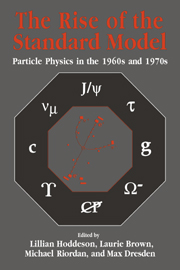Book contents
- Frontmatter
- Contents
- Contributors
- Editors' Acknowledgments
- Photographs of the Symposium
- Abbreviations and Acronyms
- Mathematical Notation
- Part One Introduction
- 1 The Rise of the Standard Model: 1964–1979
- 2 Changing Attitudes and the Standard Model
- 3 Two Previous Standard Models
- Part Two Quarks and Leptons
- Part Three Toward Gauge Theories
- Part Four Accelerators, Detectors, and Laboratories
- Part Five Electroweak Unification
- Part Six The Discovery of Quarks and Gluons
- Part Seven Personal Overviews
- Index
3 - Two Previous Standard Models
Published online by Cambridge University Press: 03 February 2010
- Frontmatter
- Contents
- Contributors
- Editors' Acknowledgments
- Photographs of the Symposium
- Abbreviations and Acronyms
- Mathematical Notation
- Part One Introduction
- 1 The Rise of the Standard Model: 1964–1979
- 2 Changing Attitudes and the Standard Model
- 3 Two Previous Standard Models
- Part Two Quarks and Leptons
- Part Three Toward Gauge Theories
- Part Four Accelerators, Detectors, and Laboratories
- Part Five Electroweak Unification
- Part Six The Discovery of Quarks and Gluons
- Part Seven Personal Overviews
- Index
Summary
Having slipped so far down the chain of being – from physicist to historian to administrator – I was very much flattered by the invitation to contribute this chapter. I shall not abuse the invitation by discussing the Standard Model itself, for you all know much more about it than I do. Instead I shall discuss two earlier physical theories (or, rather, sets of theories) that may be considered standard models of their times. My purpose is not to place the modern version in perspective – for what larger setting is possible for a theory that covers all time and all space? My purpose is to remind you that others have had the same intellectual impulses that drive contemporary particle physicists and cosmologists, and that they could point to persuasive evidence in support of their own standard models.
To qualify as a discarded standard model, a theory must have been deemed fundamental and universal; also, it must have enjoyed a wide consensus among physicists and produced quantitative results testable by experiment. These criteria are satisfied by two, and perhaps only two, previous models, which I'll call the Napoleonic and the Victorian.
The Napoleonic standard model
I call the standard model of the years around 1800 Napoleonic, not because he had anything to do with creating it, but because he patronized its principal architects, because it rose and fell coincidentally with his own career, and because it operated with the same mixture of the aristocratic and the democratic, the chauvinistic and the cosmopolitan, that characterized his regime.
- Type
- Chapter
- Information
- The Rise of the Standard ModelA History of Particle Physics from 1964 to 1979, pp. 45 - 54Publisher: Cambridge University PressPrint publication year: 1997



